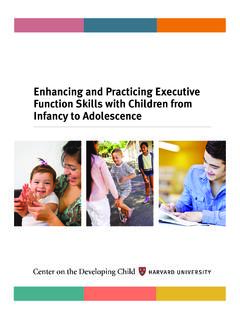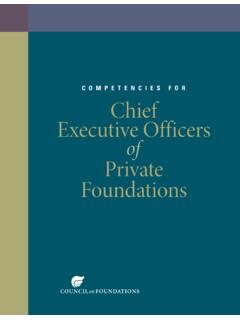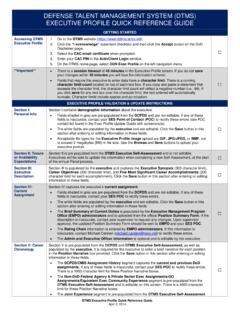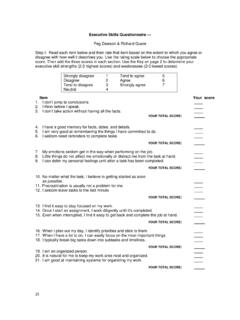Transcription of PISA 2018 Results - OECD
1 PISA 2018 Results COMBINED executive SUMMARIES. VOLUME I, II & III. PISA. P r o g r a m m e f o r I n t e r n a t i o n a l S t u d e n t A s s e s s m e n t This work is published under the responsibility of the Secretary-General of the OECD. The opinions expressed and arguments employed herein do not necessarily reflect the official views of OECD member countries. This document, as well as any data and map included herein, are without prejudice to the status of or sovereignty over any territory, to the delimitation of international frontiers and boundaries and to the name of any territory, city or area. The statistical data for Israel are supplied by and under the responsibility of the relevant Israeli authorities.
2 The use of such data by the OECD is without prejudice to the status of the Golan Heights, East Jerusalem and Israeli settlements in the West Bank under the terms of international law. Note by Turkey The information in this document with reference to Cyprus relates to the southern part of the Island. There is no single authority representing both Turkish and Greek Cypriot people on the Island. Turkey recognises the Turkish Republic of Northern Cyprus (TRNC). Until a lasting and equitable solution is found within the context of the United Nations, Turkey shall preserve its position concerning the Cyprus issue . Note by all the European Union Member States of the OECD and the European Union The Republic of Cyprus is recognised by all members of the United Nations with the exception of Turkey.
3 The information in this document relates to the area under the effective control of the Government of the Republic of Cyprus. Photo credits: Cover LuminaStock/iStock Dean Mitchell/iStock bo1982/iStock karandaev/iStock IA98/Shutterstock Tupungato/Shutterstock Corrigenda to publications may be found on line at: OECD 2019. The use of this work, whether digital or print, is governed by the Terms and Conditions to be found at executive Summary VOLUME I. Reading proficiency is essential for a wide variety of human activities from following instructions in a manual; to finding out the who, what, when, where and why of an event; to communicating with others for a specific purpose or transaction.
4 PISA. recognises that evolving technologies have changed the ways people read and exchange information, whether at home, at school or in the workplace. Digitalisation has resulted in the emergence and availability of new forms of text, ranging from the concise (text messages; annotated search-engine Results ) to the lengthy (tabbed, multipage websites; newly accessible archival material scanned from microfiches). In response, education systems are increasingly incorporating digital (reading) literacy into their programmes of instruction. Reading was the main subject assessed in PISA 2018. The PISA 2018 reading assessment, which was delivered on computer in most of the 79 countries and economies that participated, included new text and assessment formats made possible through digital delivery.
5 The test aimed to assess reading literacy in the digital environment while retaining the ability to measure trends in reading literacy over the past two decades. PISA 2018 defined reading literacy as understanding, using, evaluating, reflecting on and engaging with texts in order to achieve one's goals, to develop one's knowledge and potential, and to participate in society. WHAT STUDENTS KNOW AND CAN DO: MAIN FINDINGS. In reading Beijing, Shanghai, Jiangsu and Zhejiang (China) and Singapore scored significantly higher in reading than all other countries/. economies that participated in PISA 2018. Estonia, Canada, Finland and Ireland were the highest-performing OECD countries in reading.
6 Some 77% of students, on average across OECD countries, attained at least Level 2 proficiency in reading. At a minimum, these students are able to identify the main idea in a text of moderate length, find information based on explicit, though sometimes complex, criteria, and reflect on the purpose and form of texts when explicitly directed to do so. Over 85% of students in Beijing, Shanghai, Jiangsu and Zhejiang (China), Canada, Estonia, Finland, Hong Kong (China), Ireland, Macao (China), Poland and Singapore performed at this level or above. Around of students, on average across OECD countries, were top performers in reading, meaning that they attained Level 5 or 6 in the PISA reading test.
7 At these levels, students are able to comprehend lengthy texts, deal with concepts that are abstract or counterintuitive, and establish distinctions between fact and opinion, based on implicit cues pertaining to the content or source of the information. In 20 education systems, including those of 15 OECD countries, over 10% of 15-year-old students were top performers. In mathematics and science On average across OECD countries, 76% of students attained Level 2 or higher in mathematics. At a minimum, these students can interpret and recognise, without direct instructions, how a (simple) situation can be represented mathematically ( comparing the total distance across two alternative routes, or converting prices into a different currency).
8 However, in 24 countries and economies, more than 50% of students scored below this level of proficiency. Around one in six 15-year-old students in Beijing, Shanghai, Jiangsu and Zhejiang (China) ( ), and about one in seven students in Singapore ( ), scored at Level 6 in mathematics, the highest level of proficiency that PISA describes. These students are capable of advanced mathematical thinking and reasoning. On average across OECD countries, only of students scored at this level. On average across OECD countries, 78% of students attained Level 2 or higher in science. At a minimum, these students can recognise the correct explanation for familiar scientific phenomena and can use such knowledge to identify, in simple cases, whether a conclusion is valid based on the data provided.
9 More than 90% of students in Beijing, Shanghai, Jiangsu and Zhejiang (China) ( ), Macao (China) ( ), Estonia ( ) and Singapore ( ) achieved this benchmark. Trends in performance On average across OECD countries, mean performance in reading, mathematics and science remained stable between 2015. and 2018. PISA 2018 Results (Volume I): What Students Know and Can Do OECD 2019 15. executive Summary There were large differences between individual countries and economies in how their performance changed between 2015. and 2018. For example, mean performance in mathematics improved in 13 countries/economies (Albania, Iceland, Jordan, Latvia, Macao [China], Montenegro, Peru, Poland, Qatar, the Republic of North Macedonia, the Slovak Republic, Turkey and the United Kingdom), declined in 3 countries/economies (Malta, Romania and Chinese Taipei), and remained stable in the remaining 47 participating countries/economies.
10 Seven countries/economies saw improvements, on average, in the reading, mathematics and science performance of their students throughout their participation in PISA: Albania, Colombia, Macao (China), the Republic of Moldova, Peru, Portugal and Qatar. Seven countries saw declining mean performance across all three subjects: Australia, Finland, Iceland, Korea, the Netherlands, New Zealand and the Slovak Republic. Between 2003 and 2018, Brazil, Indonesia, Mexico, Turkey and Uruguay enrolled many more 15-year-olds in secondary education without sacrificing the quality of the education provided. Around the world, the share of 15-year-old students, in grade 7 and above, who reached a minimum level of proficiency in reading (at least Level 2 on the PISA scale) ranged from close to 90% in Beijing, Shanghai, Jiangsu and Zhejiang (China), Estonia, Macao (China) and Singapore, to less than 10% in Cambodia, Senegal and Zambia (countries that participated in the PISA for Development assessment in 2017).

















